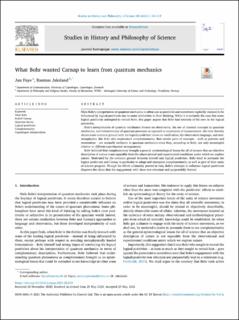| dc.contributor.author | Jaksland, Rasmus | |
| dc.contributor.author | Faye, Jan | |
| dc.date.accessioned | 2021-08-31T09:08:14Z | |
| dc.date.available | 2021-08-31T09:08:14Z | |
| dc.date.created | 2021-08-18T11:02:32Z | |
| dc.date.issued | 2021 | |
| dc.identifier.citation | Studies in History and Philosophy of Science. 2021, 88, 110-119. | en_US |
| dc.identifier.issn | 0039-3681 | |
| dc.identifier.uri | https://hdl.handle.net/11250/2771884 | |
| dc.description.abstract | Niels Bohr's interpretation of quantum mechanics is often cast as positivist and sometimes explicitly claimed to be influenced by logical positivists due to some similarities in their thinking. While it is certainly the case that some logical positivists attempted to recruit Bohr, this paper argues that Bohr had interests of his own in the logical positivists.
Bohr's interpretation of quantum mechanics focuses on observation, the use of classical concepts in quantum mechanics, and indeterminacy of quantum processes as opposed to uncertainty of measurement. His view thereby shares some common ground with the logical positivists' views on verification, the observation language, and anti-metaphysics. But Bohr also emphasized complementarity: that certain pairs of concepts – such as position and momentum – are mutually exclusive in quantum mechanics since they, according to Bohr, are only meaningful relative to different experimental arrangements.
Bohr believed that complementary brought a general epistemological lesson for all of science that an objective description of nature is not separable from the observational and experimental conditions under which we explore nature. Motivated by the common ground between himself and logical positivism, Bohr tried to persuade the logical positivists and Carnap in particular to adopt and champion complementarity as well as part of their unity of science program. Though his efforts ultimately proved in vain, Bohr's attempts to influence logical positivism disprove the claim that his engagement with them was reluctant and purposefully limited. | en_US |
| dc.language.iso | eng | en_US |
| dc.publisher | Elsevier Science | en_US |
| dc.rights | Navngivelse 4.0 Internasjonal | * |
| dc.rights.uri | http://creativecommons.org/licenses/by/4.0/deed.no | * |
| dc.title | What Bohr wanted Carnap to learn from quantum mechanics | en_US |
| dc.type | Peer reviewed | en_US |
| dc.type | Journal article | en_US |
| dc.description.version | publishedVersion | en_US |
| dc.source.pagenumber | 110-119 | en_US |
| dc.source.volume | 88 | en_US |
| dc.source.journal | Studies in History and Philosophy of Science | en_US |
| dc.identifier.doi | https://doi.org/10.1016/j.shpsa.2021.05.010 | |
| dc.identifier.cristin | 1926890 | |
| dc.description.localcode | This is an open access article distributed under the terms of the Creative Commons CC-BY license, which permits unrestricted use, distribution, and reproduction in any medium, provided the original work is properly cited. | en_US |
| cristin.ispublished | true | |
| cristin.fulltext | original | |
| cristin.qualitycode | 2 | |

